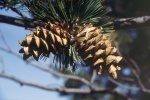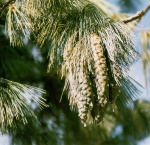Pine
| Pine |
|---|

|
| Scientific Classification |
|
| Selected Species |
|
Pines are species of coniferous trees belonging to the genus Pinus. They are in genus Pinus. The family they are in is Pinaceae. Today, it is said that there are more than 115 species of pine on the Earth. However, some scientists do not agree with it. They say that there must be more than 125 species of pine on the Earth. Pines are categorized into two groups, which are Strobus, and Pinus. However, some scientists assert that Ducampopinus should be considered to be one of Pines’ groups, too. The main difference between Strobus and Pinus is that Strobus includes one fibrovascuar bundler per leaf and Pinus includes two fibrovascular bundles per leaf.
Anatomy
Two main characteristics of pines are that pines are evergreen and resinous. Since pines are evergreen, they are also called coniferous or cone-bearing trees. The general term for a cone of a pine is a pine-cone. Most barks of pines are hard. However, there are some pines that have thin barks. Pines' branches are made in pseudowhorls. Many, but not all, pines are unidomal. It means that they only make one whorl of branch in a year.
Reproduction
Pines reproduce sexually and are monoecius, meaning they have both male and female cones. Female cones bear the ovulves and male cones shed the pollen. Each cone has many scales that are spirally arranged. However, some scales, which are located at the base and the tip of a cone do not have any seeds. They are very small and sterile.
Most seeds of a pine are very small, and have wings to assist dispersion by wind - a process called anemophilous. However, not all seeds can move by wind. There are some seeds that only have a vestigial wing and are too heavy to be moved by wind. Instead they are transported by birds or small mammals. Animals are also important for breaking open the cones that surround the seeds. There are some seeds that are released from their cones by forest fire. One good example of it is the fire climax pine. The seeds of this variety can also be released by strong heat.
Ecology
Most pines are located in the Northern Hemisphere. In North America, from the south region of Arctic to Nicaragua and Hispaniola, many pines are located. With the highest diversity In California and Mexco. In Eurasia, they are located in from Portugal and the east region of Scotland to the Russian Far East, Japan, and the Philippines. In the very Southeast Asia, there is one kind of unique pine. Most pines are generally planted easily in most parts of the Southern Hemisphere.
Acidic soil is the best place for pines to grow well. Another good place for pines is calcareous soil. Good soil drainage is required to almost every pine. Wet soils are fatal to most pines. For instance, the Lodgepole Pine is especially susceptible. There are some pines that sprout after forest fire takes a place. The Canary Island Pine is a good example. For a pine like the Bishop Pine, forest fire is a required on a periodic basis, otherwise reproduction rates are slow.
Pines like the Siberian Dwarf Pine, Mountain Pine, Whitebark Pine, and Bristlecone Pine have the ability to inhabit extremely inhospitable environments. Most of them are located in severe growth conditions related to elevation and latitude. However, these species have adapted to these climates and thrive in areas where little else is found. Pines like the Pinyon Pines, and Turkish Pines are also good examples of trees that have adapted to extremely high temperatures and drought.
Gallery
 Browse |
Related References
- Pine Wikipedia
- Pine by What are pine trees?
- Pine by Botanical.com
- Pine by Encyclopedia of Stanford Trees, Shrubs, and Vines









